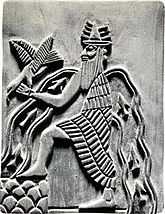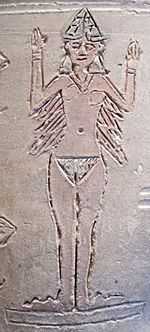Mesopotamian civilization
Historical Overview
Mesopotamian civilizations include the following: Sumer (4500 BCE - 1750 BCE), Akkad (2334 - 2154 BCE), Babylonia (1750 - 1531) and Assyria (25th or early–24th century BC to 608 BC).
Religious Beliefs
Sumerian

The Sumerian word for God was dingir (9: 114). They saw these entities as immortal and supreme. Though invisible to the naked eye, they nonetheless had their own laws that they had to abide by, lest their universe be destroyed. They also believed in a Hierarchy of gods. There were seven gods who decreed the fates, and below them, fifty deities known as the "Great Gods" (9: 115).
Mythology
Little is known about how the Sumerians believed. cosmogony. Sumerian mythology has no connection to it's rituals (9: 144). Sumerian mythology describes the origins of their Gods, along with their families, personalities, emotions, and various acts attributed to them (9: 144). Ritual, while important to the Sumerians, was a wholly separate action from their mythological beliefs (9: 144).
Gods
Major Gods
Seven gods who decreed the fates...
1.) An or Anu: Father of the Gods, God of the Heavens.
2.) Enlil: King of the Gods whose name means "Lord Sky" or "God of Air". Enlil was associated with the city of Nippur and his temple was Ekuror "House of the Mountain."
3.) Enki: Royal vizier and God of the Fresh water. His name means "Lord Earth". He was also the god of wisdom and the bringer of the Me, or the spirit of civilization. His mother was Nammu, Goddess of the Primordial sea. Enki's associated city was Eridu and his temple was E-abzu or E-en-gur-a, which means "House of the Subterranean Waters".
4.) Ninhursag: The Goddess of Nature and Enki's wife. She was the Ultimate mother goddess. Another name for her was Ninmah. Some Assyriologists think she was originally Ki, mother of the gods. Her temple was Esagila, located in Eridu.

5.) Nanna: God of the moon, sometimes called Nanna-Suen. Father of Utu and Inanna. The Akkadians knew him as Sin. Nanna was associated with the city Ur and his temple was called E-gish-shir-gal or "House of the Great Light".
6.) Utu: God of the Sun. In some source material he is known as Inanna's twin brother. Because he saw all before him, he was also known as the god of justice. It is said that when the sun set, Utu went into the Underworld to decree the Fates of the Dead. His temples were called E-babbar or the "White House" and were located in Sippar, Akkad, and Larsa in Southern Sumer.
7.) Inanna: Goddess of War, Fertility, Sex and Holy Prostitution. She once got Enki drunk and stole the 100 Me from him. The planet Venus was associated with her. Inanna's holy city was Uruk and her main temple was Eanna or "House of Heaven", or "An".
Underworld Gods
- Erishkigal: Inanna's sister and bitter rival. She was queen of the Underworld, sometimes called Kigal or Kur. She was once known to be beautiful if severe. Originally married to the Great Bull of Heaven, Gugalana, her husband was killed by Gilgamesh and Enkidu when Inanna's advances were rejected by Gilgamesh. In a fit of pique, Inanna begged Enlil to release the Bull of Heaven to wreak havoc upon Gilgamesh and his city. After his death, Gilgamesh served as one of the judges in the Underworld.
- Dumuzi: Deified King who spent half the year in the Underworld and half the year with Inanna, his consort.
- Gilgamesh: Deified king, who upon his death, took his place as one of the Underworld's Gods.
- Namtar: Minister of Ereshkigal. In one telling of a myth, he was the son of Enlil and Ninlil. He shares his name with a demon of the nether world, a harbinger of death. In Sumerian, his name meant "fate" or "destiny" (1: 134)
- Ningishzida: Son of Ninazu. His name means "Lord of the Good Tree". He is mentioned as a guardians of over the demons of the Underworld. There is a story where he and Dumuzi are guarding the Gates to Heaven, to Anu, from a mortal named Adapa. From Adapa's reaction, it is highly unusual for Ningishzida to be seen out of the Underworld. His symbol and beast was the horned snake or dragon bašmu and his constellation was the Hydra (1: 138-140).
Minor Gods
- Ashnan: Goddess of Grain and Vegetables (10: 173)
- Enkimdu: Enlil's Farmer, God of "plow, yoke and furrow" (10: 173)
- Geshtinanna: Sister of Dumuzi who spent half the year in the Underworld and half the year in the Mortal realms. She was a "divine poetess, singer and interpreter of dreams" (10: 157).
- Ishkur: God of Storms...(10: 173)
- Kulla: Brick God in charge of pick axes and brick molds (10: 173).
- Mushdamma: "Great Builder of Enlil" who protects Enlil's temples (10: 173).
- Nanshe: Goddess of Justice and interpreter of dreams. Married to Haia. She also watched over Widows and Orphans (10: 124, 130).
- Nidaba: Patroness of Schools, Goddess of Writing and Accounts. Attendant deity to Nanshe (10: 125).
- Nindub: God of Architects.
- Ningal: Wife to Nanna.
- Ningirsu: Nanshe's Brother, married to Bau, God of Rain, Irrigation and Fertility. Some scholars liken him to Ninurta.
- Ninkasi: Her name literally means "The Lady who fills the mouth." She was a goddess of beer preparation. (10: 111)
- Ninkilim: Farmers prayed to this goddess to keep their fields free of mice and vermin. (10: 106)
- Ninlil: Wife to Enlil. She and Enlil, in one myth, were the parents of Nanna, God of the Moon. Her parents are said to be Haia, God of Grain Stores and Ninshebargunu or Nidaba, Goddess of Barley. Ninlil means Lady Wind. She was also seen as a mother Goddess and was quite warm and welcoming. (9: 99)
- Ninurta: God of the Stormy South Wind, the wind of fire and disease (10: 151). Some scholars liken him to Ningirsu.
- Siduri: Barkeep and Wise one whom Gilgamesh meets on his way to meet Utnapishtim or Ziusudra, an Immortal who survived the flood.
Akkadian
Gods
Major Gods
Ishtar: Goddess of Sex, War, Fertility and Holy Prostitution. She is the Akkadian variant of Inanna.
Šamaš: Pronounced Shamash. Sun god of the Akkadians.
Magic and Superstition
Assyria
The person is takla
Source Material
On Mesopotamia
1. Black, Jeremy and Green, Anthony. Gods, Demons and Symbols of Ancient Mesopotamia. University of Texas Press, Austin, TX. 1992. ISBN 13: 978-0-292-70794-8
2. Bottéro, Jean. Everyday Life in Ancient Mesopotamia. John Hopkins University Press, Baltimore, MD. 2001. ISBN: 098018-6864-5
3. Bottéro, Jean. Mesopotamia: Writing, Reasoning and the Gods. University of Chicago Press, Chicago, IL. 1992. ISBN: 0-226-06727-0.
4. Bottéro, Jean. Religion in Ancient Mesopotamia. University of Chicago Press, Chicago, IL. 2004. ISBN 13: 978-0-226-06718-6
5. Edited by Bottéro, Jean. Cassin, Elena. Vercoutter, Jean. The Near East: The Early Civilizations. Delacorte Press, New York. 1965. ISBN-13: 978-0297748915
6. Nemet-Nejat, Karen Rhea. Daily Life in Ancient Mesopotamia. Greenwood Press, Westport, CT. 1998. ISBN: 0-313-29497-6
7. Oppenheim, Leo, A. Ancient Mesopotamia. University of Chicago Press, Chicago, IL. 1977. ISBN: 0-226-63187-7
8. Roux, Georges. Ancient Iraq. Penguin Books, London, England. 1992. ISBN: 978-0-14-012523-8
9. Jacobsen, Thorkild. The Treasures of Darkness. Yale University Press, New Haven and London. 1976. ISBN: 978-0-300-02291-9
On Sumer
10. Kramer, Samuel Noah. The Sumerians: Their History, Culture, and Character. University of Chicago Press, Chicago, IL. 1963. ISBN 13: 978-0-226-45238-8.